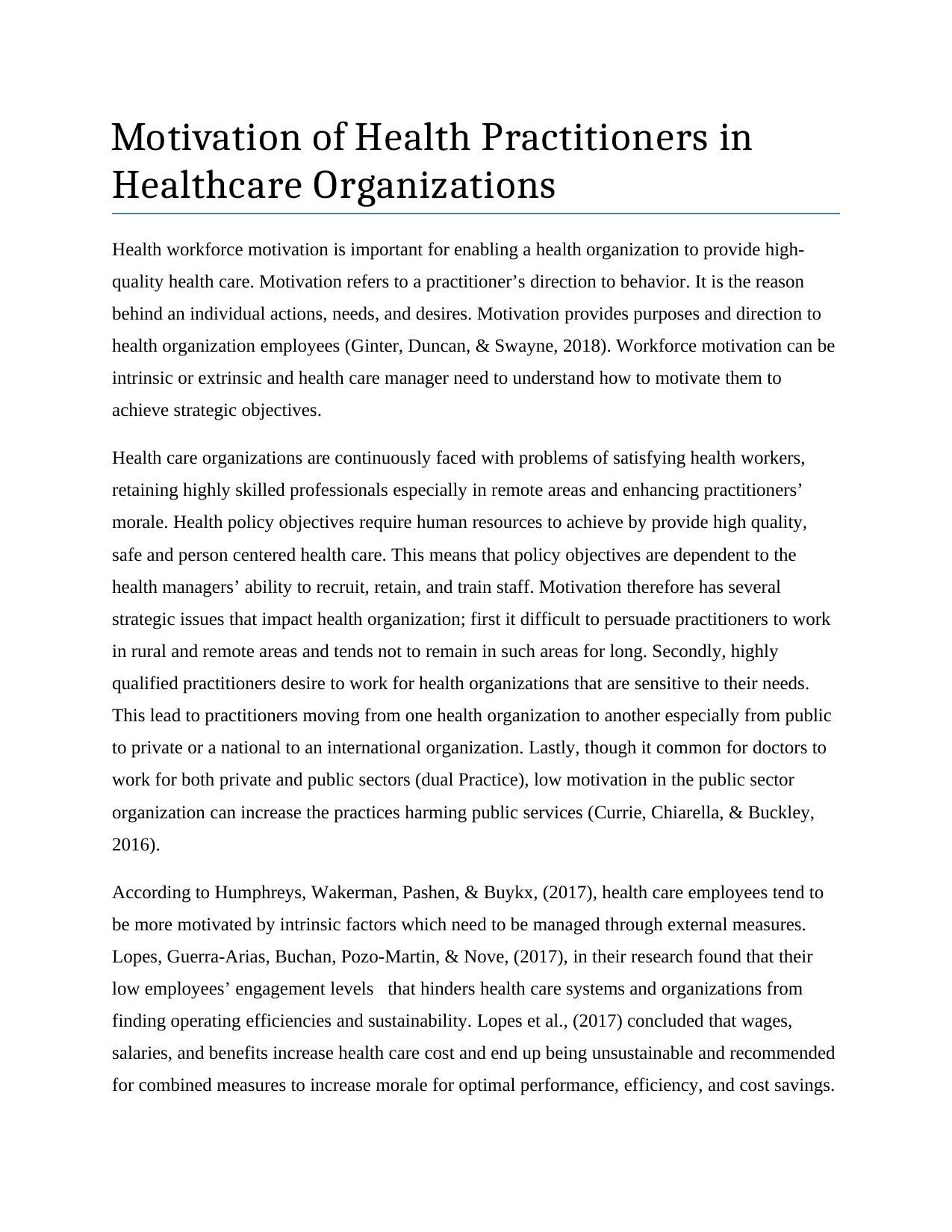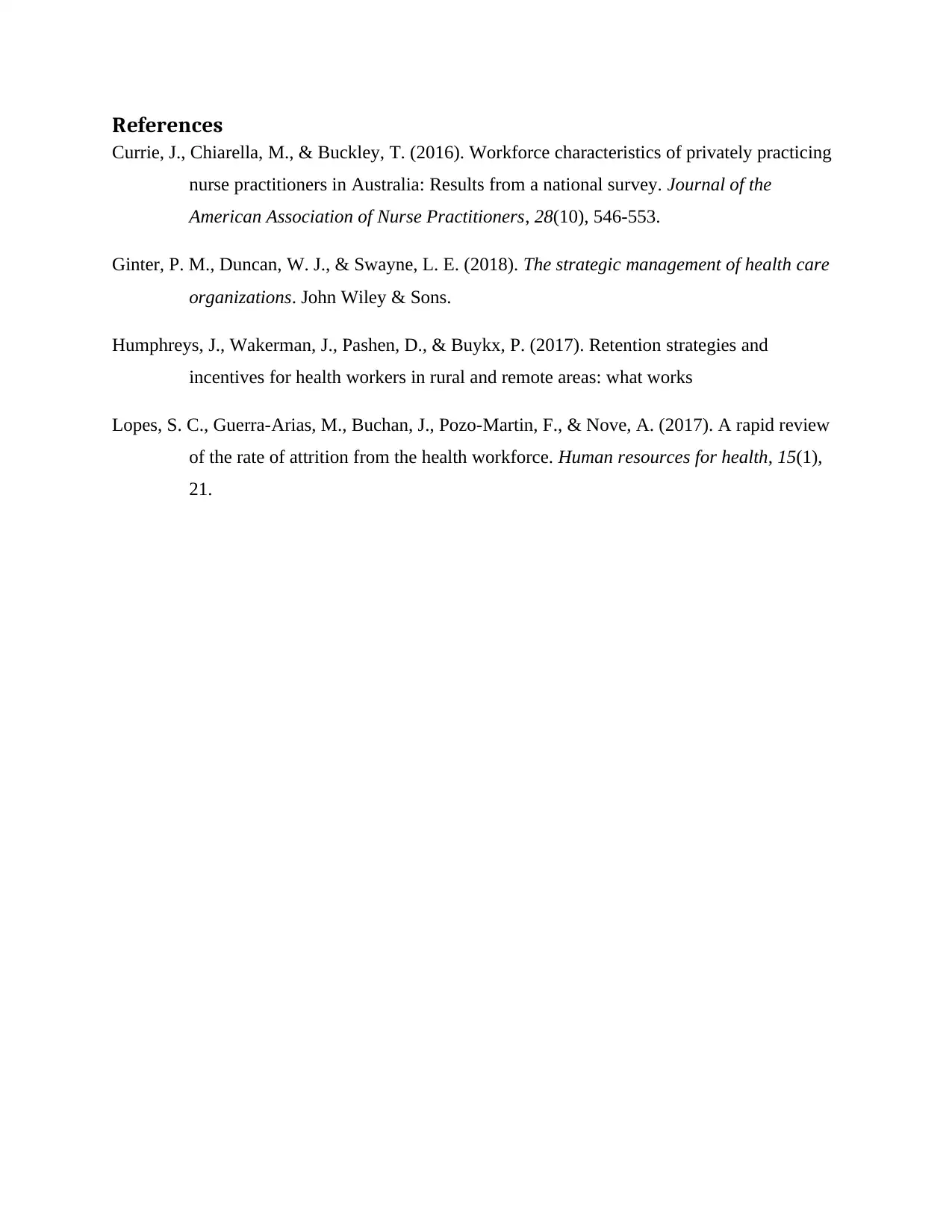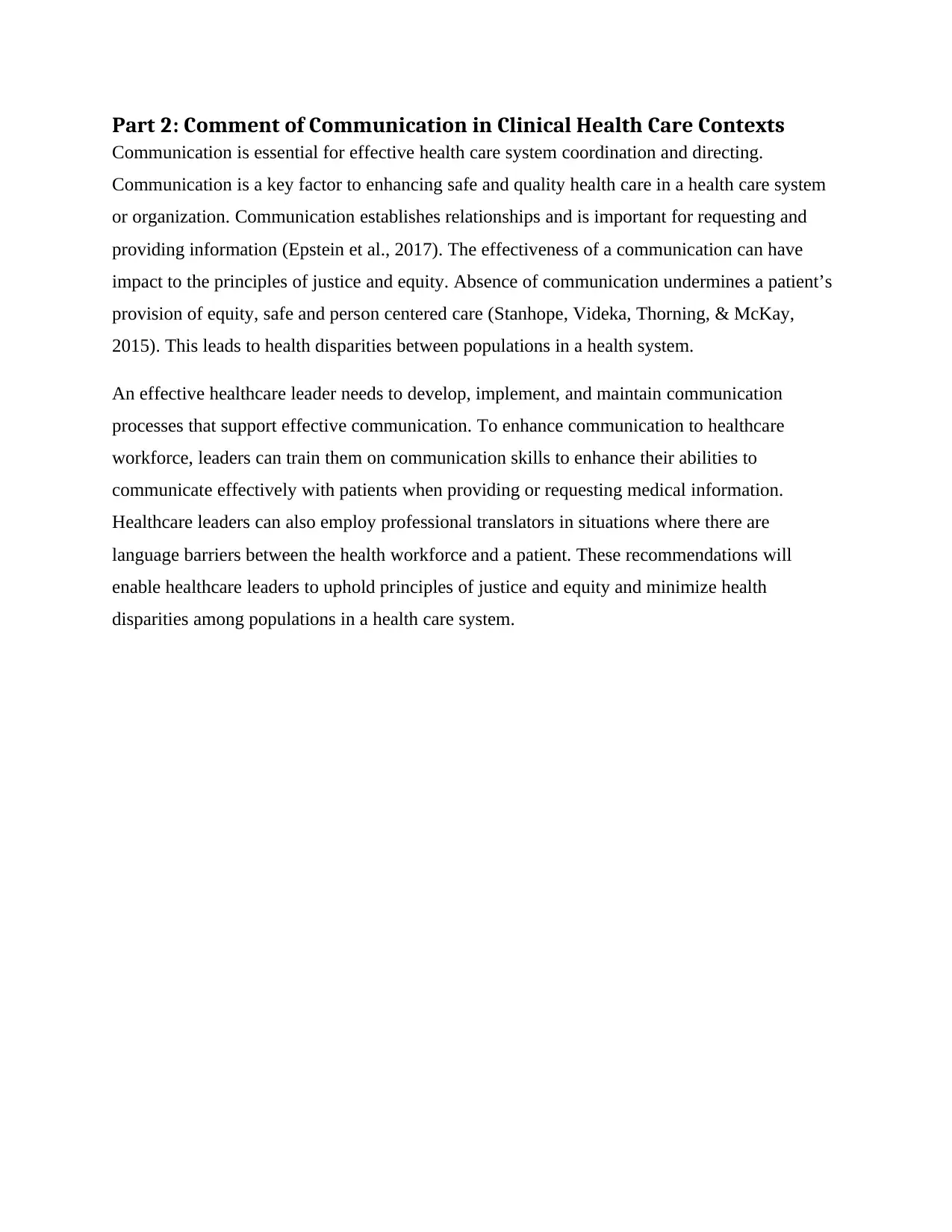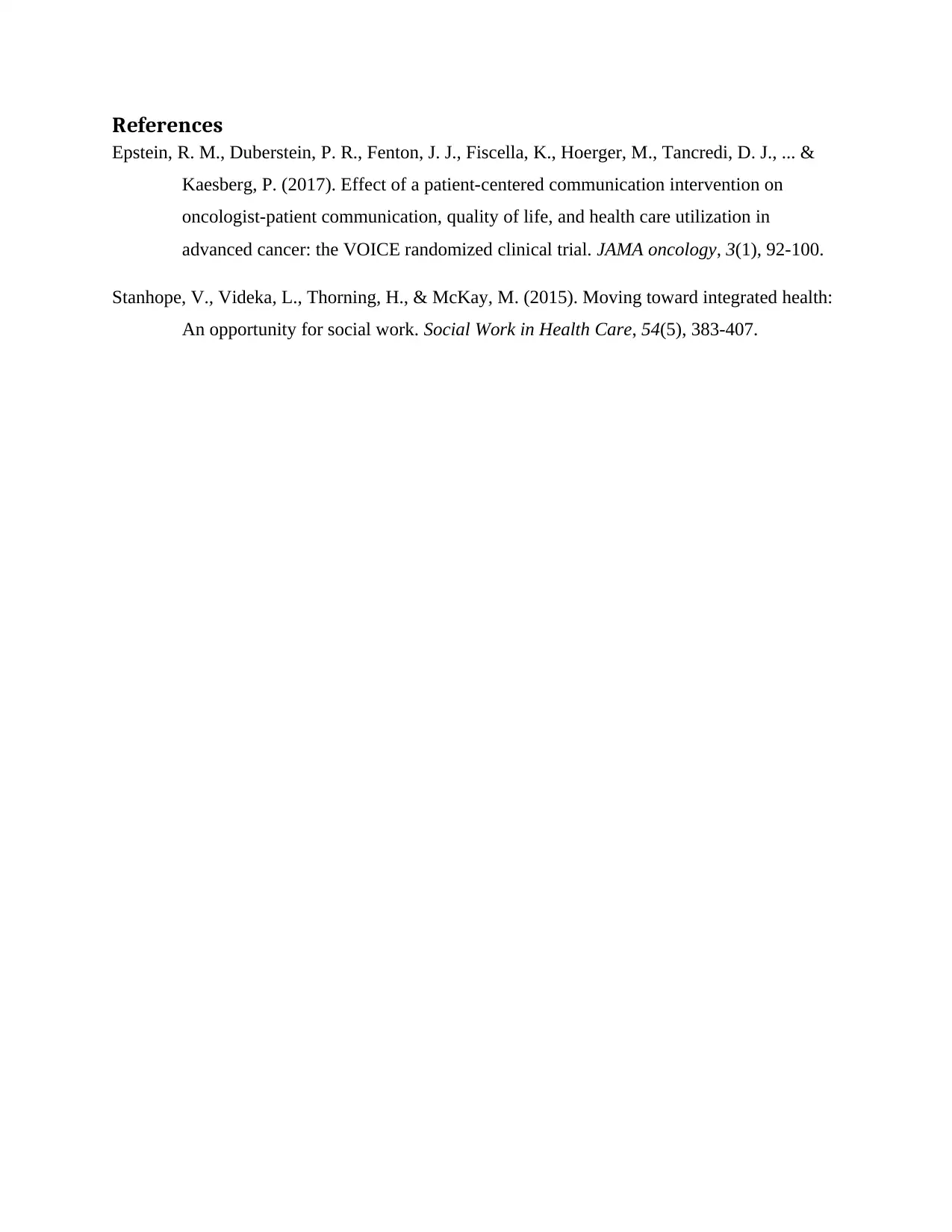Motivation of Health Practitioners and Communication in Clinical Health Care Contexts
VerifiedAdded on 2023/06/08
|6
|953
|331
AI Summary
This article discusses the importance of motivation and communication in healthcare organizations. It explores the challenges of motivating health practitioners and enhancing communication for effective healthcare system coordination and directing. The article also provides recommendations for healthcare leaders to uphold principles of justice and equity and minimize health disparities among populations in a healthcare system.
Contribute Materials
Your contribution can guide someone’s learning journey. Share your
documents today.

UNIT:
DATE:
NAME:
DATE:
NAME:
Secure Best Marks with AI Grader
Need help grading? Try our AI Grader for instant feedback on your assignments.

Motivation of Health Practitioners in
Healthcare Organizations
Health workforce motivation is important for enabling a health organization to provide high-
quality health care. Motivation refers to a practitioner’s direction to behavior. It is the reason
behind an individual actions, needs, and desires. Motivation provides purposes and direction to
health organization employees (Ginter, Duncan, & Swayne, 2018). Workforce motivation can be
intrinsic or extrinsic and health care manager need to understand how to motivate them to
achieve strategic objectives.
Health care organizations are continuously faced with problems of satisfying health workers,
retaining highly skilled professionals especially in remote areas and enhancing practitioners’
morale. Health policy objectives require human resources to achieve by provide high quality,
safe and person centered health care. This means that policy objectives are dependent to the
health managers’ ability to recruit, retain, and train staff. Motivation therefore has several
strategic issues that impact health organization; first it difficult to persuade practitioners to work
in rural and remote areas and tends not to remain in such areas for long. Secondly, highly
qualified practitioners desire to work for health organizations that are sensitive to their needs.
This lead to practitioners moving from one health organization to another especially from public
to private or a national to an international organization. Lastly, though it common for doctors to
work for both private and public sectors (dual Practice), low motivation in the public sector
organization can increase the practices harming public services (Currie, Chiarella, & Buckley,
2016).
According to Humphreys, Wakerman, Pashen, & Buykx, (2017), health care employees tend to
be more motivated by intrinsic factors which need to be managed through external measures.
Lopes, Guerra-Arias, Buchan, Pozo-Martin, & Nove, (2017), in their research found that their
low employees’ engagement levels that hinders health care systems and organizations from
finding operating efficiencies and sustainability. Lopes et al., (2017) concluded that wages,
salaries, and benefits increase health care cost and end up being unsustainable and recommended
for combined measures to increase morale for optimal performance, efficiency, and cost savings.
Healthcare Organizations
Health workforce motivation is important for enabling a health organization to provide high-
quality health care. Motivation refers to a practitioner’s direction to behavior. It is the reason
behind an individual actions, needs, and desires. Motivation provides purposes and direction to
health organization employees (Ginter, Duncan, & Swayne, 2018). Workforce motivation can be
intrinsic or extrinsic and health care manager need to understand how to motivate them to
achieve strategic objectives.
Health care organizations are continuously faced with problems of satisfying health workers,
retaining highly skilled professionals especially in remote areas and enhancing practitioners’
morale. Health policy objectives require human resources to achieve by provide high quality,
safe and person centered health care. This means that policy objectives are dependent to the
health managers’ ability to recruit, retain, and train staff. Motivation therefore has several
strategic issues that impact health organization; first it difficult to persuade practitioners to work
in rural and remote areas and tends not to remain in such areas for long. Secondly, highly
qualified practitioners desire to work for health organizations that are sensitive to their needs.
This lead to practitioners moving from one health organization to another especially from public
to private or a national to an international organization. Lastly, though it common for doctors to
work for both private and public sectors (dual Practice), low motivation in the public sector
organization can increase the practices harming public services (Currie, Chiarella, & Buckley,
2016).
According to Humphreys, Wakerman, Pashen, & Buykx, (2017), health care employees tend to
be more motivated by intrinsic factors which need to be managed through external measures.
Lopes, Guerra-Arias, Buchan, Pozo-Martin, & Nove, (2017), in their research found that their
low employees’ engagement levels that hinders health care systems and organizations from
finding operating efficiencies and sustainability. Lopes et al., (2017) concluded that wages,
salaries, and benefits increase health care cost and end up being unsustainable and recommended
for combined measures to increase morale for optimal performance, efficiency, and cost savings.

Motivation in health organization can be enhanced by recognizing job well done, letting health
worker know how their roles fit in the organizational goals, minimizing obstacles and barriers in
their practice and health organization managers managing motivation as a long term strategy.
worker know how their roles fit in the organizational goals, minimizing obstacles and barriers in
their practice and health organization managers managing motivation as a long term strategy.

References
Currie, J., Chiarella, M., & Buckley, T. (2016). Workforce characteristics of privately practicing
nurse practitioners in Australia: Results from a national survey. Journal of the
American Association of Nurse Practitioners, 28(10), 546-553.
Ginter, P. M., Duncan, W. J., & Swayne, L. E. (2018). The strategic management of health care
organizations. John Wiley & Sons.
Humphreys, J., Wakerman, J., Pashen, D., & Buykx, P. (2017). Retention strategies and
incentives for health workers in rural and remote areas: what works
Lopes, S. C., Guerra-Arias, M., Buchan, J., Pozo-Martin, F., & Nove, A. (2017). A rapid review
of the rate of attrition from the health workforce. Human resources for health, 15(1),
21.
Currie, J., Chiarella, M., & Buckley, T. (2016). Workforce characteristics of privately practicing
nurse practitioners in Australia: Results from a national survey. Journal of the
American Association of Nurse Practitioners, 28(10), 546-553.
Ginter, P. M., Duncan, W. J., & Swayne, L. E. (2018). The strategic management of health care
organizations. John Wiley & Sons.
Humphreys, J., Wakerman, J., Pashen, D., & Buykx, P. (2017). Retention strategies and
incentives for health workers in rural and remote areas: what works
Lopes, S. C., Guerra-Arias, M., Buchan, J., Pozo-Martin, F., & Nove, A. (2017). A rapid review
of the rate of attrition from the health workforce. Human resources for health, 15(1),
21.
Secure Best Marks with AI Grader
Need help grading? Try our AI Grader for instant feedback on your assignments.

Part 2: Comment of Communication in Clinical Health Care Contexts
Communication is essential for effective health care system coordination and directing.
Communication is a key factor to enhancing safe and quality health care in a health care system
or organization. Communication establishes relationships and is important for requesting and
providing information (Epstein et al., 2017). The effectiveness of a communication can have
impact to the principles of justice and equity. Absence of communication undermines a patient’s
provision of equity, safe and person centered care (Stanhope, Videka, Thorning, & McKay,
2015). This leads to health disparities between populations in a health system.
An effective healthcare leader needs to develop, implement, and maintain communication
processes that support effective communication. To enhance communication to healthcare
workforce, leaders can train them on communication skills to enhance their abilities to
communicate effectively with patients when providing or requesting medical information.
Healthcare leaders can also employ professional translators in situations where there are
language barriers between the health workforce and a patient. These recommendations will
enable healthcare leaders to uphold principles of justice and equity and minimize health
disparities among populations in a health care system.
Communication is essential for effective health care system coordination and directing.
Communication is a key factor to enhancing safe and quality health care in a health care system
or organization. Communication establishes relationships and is important for requesting and
providing information (Epstein et al., 2017). The effectiveness of a communication can have
impact to the principles of justice and equity. Absence of communication undermines a patient’s
provision of equity, safe and person centered care (Stanhope, Videka, Thorning, & McKay,
2015). This leads to health disparities between populations in a health system.
An effective healthcare leader needs to develop, implement, and maintain communication
processes that support effective communication. To enhance communication to healthcare
workforce, leaders can train them on communication skills to enhance their abilities to
communicate effectively with patients when providing or requesting medical information.
Healthcare leaders can also employ professional translators in situations where there are
language barriers between the health workforce and a patient. These recommendations will
enable healthcare leaders to uphold principles of justice and equity and minimize health
disparities among populations in a health care system.

References
Epstein, R. M., Duberstein, P. R., Fenton, J. J., Fiscella, K., Hoerger, M., Tancredi, D. J., ... &
Kaesberg, P. (2017). Effect of a patient-centered communication intervention on
oncologist-patient communication, quality of life, and health care utilization in
advanced cancer: the VOICE randomized clinical trial. JAMA oncology, 3(1), 92-100.
Stanhope, V., Videka, L., Thorning, H., & McKay, M. (2015). Moving toward integrated health:
An opportunity for social work. Social Work in Health Care, 54(5), 383-407.
Epstein, R. M., Duberstein, P. R., Fenton, J. J., Fiscella, K., Hoerger, M., Tancredi, D. J., ... &
Kaesberg, P. (2017). Effect of a patient-centered communication intervention on
oncologist-patient communication, quality of life, and health care utilization in
advanced cancer: the VOICE randomized clinical trial. JAMA oncology, 3(1), 92-100.
Stanhope, V., Videka, L., Thorning, H., & McKay, M. (2015). Moving toward integrated health:
An opportunity for social work. Social Work in Health Care, 54(5), 383-407.
1 out of 6
Your All-in-One AI-Powered Toolkit for Academic Success.
+13062052269
info@desklib.com
Available 24*7 on WhatsApp / Email
![[object Object]](/_next/static/media/star-bottom.7253800d.svg)
Unlock your academic potential
© 2024 | Zucol Services PVT LTD | All rights reserved.